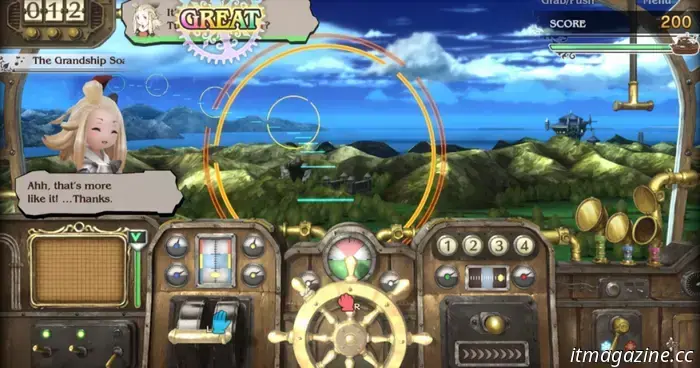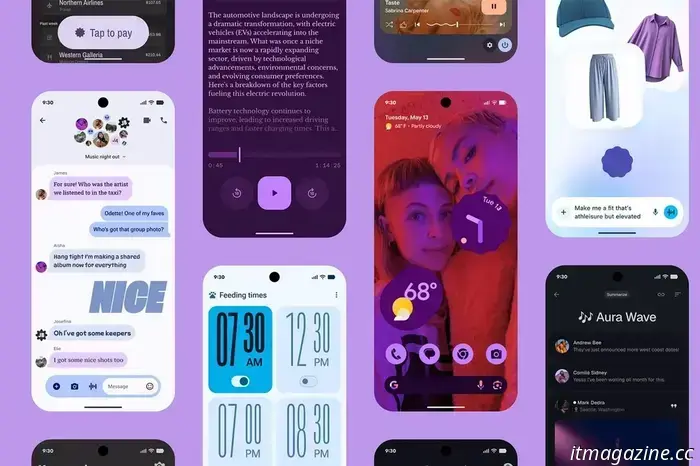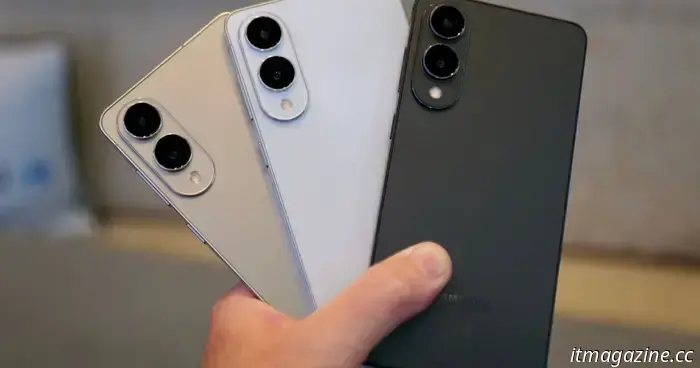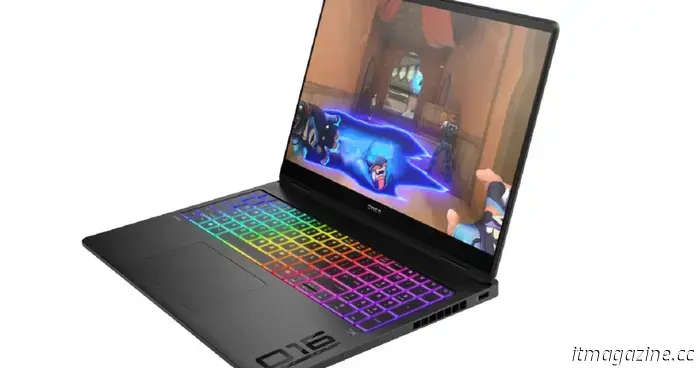
Bravely Default HD Remaster demonstrates the capabilities of the Switch 2’s mouse controls for the party.
If I were to characterize Bravely Default from 2012, "party game" would be the last label I'd apply. In reality, the Nintendo 3DS RPG stands in stark contrast to party games. It's an extensive, intricate journey that demands a considerable amount of patience to finish. Thus, I was somewhat surprised when the first thought that came to mind after trying out the demo for its upcoming Switch 2 version, Bravely Default: Flying Fairy HD Remaster, was that it really highlights the party potential of Nintendo’s new console.
This isn't due to any changes in the RPG itself; rather, it pertains to the new additional content. During a hands-on demonstration, I had the chance to experience the remaster’s two new minigames, which are accessible as bonuses from the main menu. Both minigames cleverly utilize the Switch 2’s mouse controls, leaving me even more excited to see what developers might create using the unique two Joy-Con setup.
I had only a short amount of time to explore the remaster, so I chose to jump directly into the new content instead of the main game. However, for those interested, expect a straightforward remaster rather than a complete remake, with one significant exception. Everything has been adjusted to fit the original two-screen game onto a single screen. Otherwise, you can anticipate mostly enhanced visuals that refine the jagged edges of the 3DS version, bringing it more in line with 2021’s Bravely Default 2.
Now, let’s focus on the minigames. The first one I tried, Luxencheer Rhythm Catch, is a music game designed around mouse controls. In this game, I wasn’t just pressing buttons in time with the music. Bubbles would flow forward, and I had to pop them at the right time by maneuvering my two controllers. A line connected my pointers on the screen, and I had to ensure it intersected the bubbles to pop them accurately. When colorful flowers appeared, I needed to slide my Joy-Con to them and hold the trigger to hit the beat. Additionally, when a line showed up, I had to pull both controllers to its center to properly hit the beat.
This felt reminiscent of a fantastic Mario Party minigame. I had to position my hands with care, as the Switch 2’s mouse controls are remarkably accurate. A misplaced move could lead to sliding my hand too far, causing the line between my pointers to miss a bubble. It’s a clever twist on a traditional rhythm game that offers a pleasant distraction from an intricate RPG.
The second minigame, Ringabel’s Panic Cruise, utilizes the mouse controls even further. Here, I had to navigate my airship through a series of rings. It was straightforward enough. I controlled the ship from a cockpit view, using a wheel to steer and a lever to adjust elevation. Each could be controlled independently with my mice, allowing me to maneuver the ship effectively. However, this task was complicated when my crew occasionally required me to manage the ship through a control panel near my wheel. At one point, I had to replace a fuse by retrieving one from the side of the screen and swapping it with a broken one. Later, I was asked to check if certain switches were functional, dial a specific number on a panel, and grab a flyswatter to deal with some bothersome flies—perhaps a nod to Mario Paint. Of course, I had to accomplish all of this while steering the ship.
It felt a bit like a single-player version of Spaceteam combined with the Wii U's underrated title Affordable Space Adventures. It was a balancing act requiring me to manage two or three tasks simultaneously, leading to some amusing chaos as I rushed to finish a task while quickly straightening the ship again. Though it’s just a small side game, it really demonstrates the creativity that developers could unleash with a two-mouse control scheme if they’re open to experimenting.
I am particularly excited to see this creativity manifest in party games. At the conclusion of my demo, I asked if I could attempt the rhythm game with two players using one set of Joy-Cons. I grabbed the left one while a friend took control of the right. We needed to cooperate to position our mice as we tackled a song on hard mode, which increases the prompt speed on-screen. It was as hilarious as one could imagine, as we tried to navigate around each other’s movements when one of us was out of place.
I hope this energetic dynamic translates to series like WarioWare, because there's significant co-op party potential in these two minigames. I would love to see innovative games similar to Snipperclips showcased on the Switch 2 early in its life cycle, demonstrating the platform's unique capabilities. Until then, Bravely Default: Flying Fairy HD Remaster will serve as a small teaser attached to a cherished RPG. While these mini-games might not be reason enough on their own


Other articles
 TNW Backstage embraces a dual approach to tech humor.
The second episode of TNW Backstage showcases Double Dutch creator Derek Mitchell alongside Dutch tech icon Boris, discussing the business value of laughter.
TNW Backstage embraces a dual approach to tech humor.
The second episode of TNW Backstage showcases Double Dutch creator Derek Mitchell alongside Dutch tech icon Boris, discussing the business value of laughter.
 The new Android OS will have more decorations and a little Gemini.
Android OS has entered a period of its development when, instead of increasing functionality, new versions and updates are a set of new colorful and shiny backgrounds, fonts, icons and other pleasant trinkets. So, the main innovation that will appear in Android 16 and Wear OS 6 is the new Material 3 Expressive design. However, the Gemini AI will also be present there.
The new Android OS will have more decorations and a little Gemini.
Android OS has entered a period of its development when, instead of increasing functionality, new versions and updates are a set of new colorful and shiny backgrounds, fonts, icons and other pleasant trinkets. So, the main innovation that will appear in Android 16 and Wear OS 6 is the new Material 3 Expressive design. However, the Gemini AI will also be present there.
 This is the top preorder offer for the Samsung Galaxy S25 Edge.
The Samsung Galaxy S25 Edge is the slimmest smartphone in Samsung's Galaxy S lineup to date, and there are some promotions available if you preorder it at this time.
This is the top preorder offer for the Samsung Galaxy S25 Edge.
The Samsung Galaxy S25 Edge is the slimmest smartphone in Samsung's Galaxy S lineup to date, and there are some promotions available if you preorder it at this time.
 The 5 key insights from the unveiling of Google's Android 16
Android 16 is set to be a significant update, and here’s what you should be aware of from its announcement.
The 5 key insights from the unveiling of Google's Android 16
Android 16 is set to be a significant update, and here’s what you should be aware of from its announcement.
 Exclusive: This marks Wiim's inaugural wireless speaker.
Wiim's impending clash with Sonos appears increasingly unavoidable with this latest enhancement to its ecosystem.
Exclusive: This marks Wiim's inaugural wireless speaker.
Wiim's impending clash with Sonos appears increasingly unavoidable with this latest enhancement to its ecosystem.
 The formidable HP Omen Max 16 gaming laptop featuring the RTX 5070 Ti is currently reduced by $350.
The HP Omen Max 16 gaming laptop, featuring the Intel Core Ultra 7 255HX processor and Nvidia GeForce RTX 5070 Ti graphics card, is currently available at a $350 discount from HP.
The formidable HP Omen Max 16 gaming laptop featuring the RTX 5070 Ti is currently reduced by $350.
The HP Omen Max 16 gaming laptop, featuring the Intel Core Ultra 7 255HX processor and Nvidia GeForce RTX 5070 Ti graphics card, is currently available at a $350 discount from HP.
Bravely Default HD Remaster demonstrates the capabilities of the Switch 2’s mouse controls for the party.
We tested the new minigames in Bravely Default: Flying Fairy HD Remaster for Switch 2, which effectively utilize the system's mouse controls.
